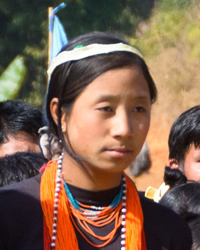Identifying the Gongwang Naga is complex due to their close relationship and proximity to the larger Ponyo tribe, who inhabit 30 villages. The two groups speak closely related dialects, so linguists have combined them into a language called Ponyo-Gongwang Naga, spoken by 15,000 people. Despite outsiders having no hesitation in labeling the two tribes as one, “both groups deny a connection.” The Gongwang also acknowledge cultural and linguistic links with the Lainong and Khiamniungan Naga tribes, while other people in the area often refer to them as “Tsawlaw,” which is the name of their largest village.
Location: Nearly 5,000 members of the Gongwang Naga tribe live in western Myanmar's Sagaing Region, along the border with India. The Gongwang Nagas inhabit ten villages in Lahe Township within the Naga Self-Administered Zone. The main Gongwang village of Tsawlaw was once feared on both sides of the Myanmar-India border, and “raiding was of such concern to the authorities that in 1948 plans were made to burn down the village to limit the spread of violence along the frontier.” Today, a few hundred Gongwang people reside on the Indian side of the border. Some have moved there to conduct business or for their children's education, while others have fled in recent years to escape the turmoil of war-torn Myanmar.
Language: Gongwang is one of several Naga languages in western Myanmar related to Northern Chin varieties, suggesting a historic link between the two. Scholars have found that Gongwang shares an 89 percent lexical similarity with Ponyo Naga, 69 percent with Lainong Naga, and 67 percent with Khiamniungan Naga. The Gongwang language is spoken by all tribe members, and a Roman-based script has been used by them since 2014.
For centuries the Gongwang Naga engaged in headhunting raids against other tribes and were particularly renowned for their fierce bloodlust. Massacres were often done in retaliation for an attack or insult, while a strong desire to appease the spirits undergirded the dark practice. In 1936, the Gongwang joined forces with their Ponyo counterparts and sent a large raiding party to the Khiamniungan village of Pangsa. The warriors returned with 188 human heads and many prisoners of war.4 A consequence of World War Two was that headhunting markedly increased, due to the number of guns captured or left behind the area. In 1941 the Gongwang took 150 heads in one raid, while in 1948 they were part of a group of warriors that destroyed the Konyak village of Choknyu, in an attack that netted at least 400 heads.
When the British officer Terence Dewar visited the Gongwang Nagas in the early 1930s, he found a style of housing not seen among any other tribe in the area. He wrote: “A circular hole is left at one end of their homes, and a ladder reaches the floor below. In one of these houses up to 30 couples can be accommodated in beds cleverly built into the sides of the wall around a central fireplace.” Traditional slash-and-burn agriculture practiced by the Gongwang has been replaced by more sustainable methods. Today, many families “raise chickens and pigs, while hunting for wild animals provides additional sources of meat. The successful hunter shares the meat with other villagers and keeps the animal's head for himself.”
After centuries of devotion to demons that caused the Gongwang Nagas to live in bondage and violence, they began converting to Christianity in the 1970s, and today an estimated 60 percent of the tribe are followers of Jesus. There are also significant numbers of Buddhists among them, while many families have continued to engage in the animistic rituals of their forefathers.
Naga Christians in the Lahe area have occasionally faced severe persecution for their faith. In 2009, “the Myanmar army severely beat six people for the whole day in Lahe Township for converting from Animism to Christianity, and as a result, two of them died…. In addition, there are many reported cases of rape and torture.” No Scripture has ever been translated into Gongwang. A local believer shared: “We use multiple languages because we don't yet have a Bible in our own language. It depends on the person and what language they understand best. Some use Burmese, some English, some Khiamniungan, and some use the Ao language from Nagaland, India.”
Scripture Prayers for the Naga, Gongwang in Myanmar (Burma).
| Profile Source: Asia Harvest |











